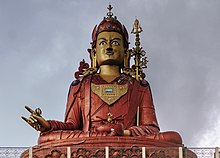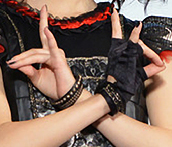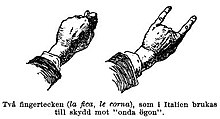Sign of the horns
hideThis article has multiple issues. Please help or discuss these issues on the talk page. (Learn how and when to remove these template messages)
|

The sign of the horns is a hand gesture with a variety of meanings and uses in various cultures. It is formed by extending the index and little fingers while holding the middle and ring fingers down with the thumb.
Religious and superstitious meaning[]

In Hatha Yoga, a similar hand gesture – with the tips of middle and ring finger touching the thumb – is known as Apāna Mudrā, a gesture believed to rejuvenate the body.[1] In Indian classical dance forms, it symbolises the lion.[1] In Buddhism, the Karana Mudrā is seen as an apotropaic gesture to expel demons, remove negative energy, and ward off evil. It is commonly found on depictions of Gautama Buddha.[1][2] It is also found on the Song dynasty statue of Laozi, the founder of Taoism, on Mount Qingyuan, China.[3]
The apotropaic usage of the sign can also be seen in Italy and in other Mediterranean cultures where, when confronted with unfortunate events, or simply when these events are mentioned, the sign of the horns may be given to ward off further bad luck. It is also used traditionally to counter or ward off the "evil eye" (malocchio in Italian). In Italy specifically, the gesture is known as the corna ("horns"). With fingers pointing down, it is a common Mediterranean apotropaic gesture, by which people seek protection in unlucky situations (a Mediterranean equivalent of knocking on wood). The President of the Italian Republic Giovanni Leone startled the media when, while in Naples during an outbreak of cholera, he shook the hands of patients with one hand while with the other behind his back he superstitiously made the corna, presumably to ward off the disease or in reaction to being confronted by such misfortune. This act was well documented by the journalists and photographers who were right behind him, a fact that had escaped President Leone's mind in that moment.[citation needed]
In Italy and other parts of the Mediterranean region, the gesture must usually be performed with the fingers tilting downward to signify the warding off of bad luck; in the same region and elsewhere, the gesture may take a different, offensive and insulting meaning if it is performed with fingers upward or if directed aggressively towards someone in a swiveling motion (see section below). In Italy, one can also "touch iron" (tocca ferro) or touch one's nose to ward off bad luck. Males in Italy may also grab their testicles when confronted by bad luck; however, this is considered more vulgar.
In Peru, one says contra (against). In the Dominican Republic, the expression is zafa, said against curses known as fukú. All of these gestures are meant to conjure supernatural protection.
The sign of the horns is used during religious rituals in Wicca, to invoke or represent the Horned god.[4]
In LaVeyan Satanism, the sign of the horns is used as a traditional salutation, either for informal or ritual purposes.[5]
Offensive gesture[]
In many Mediterranean and Latin countries, such as Brazil, Greece, Italy, Portugal, Spain, Mexico[6][7][8][9] when directed towards someone and swiveled back and forth, the sign implies cuckoldry; the common words for cuckolded in Italian, Greek, Spanish, and Portuguese are, respectively, cornuto, κερατάς (keratas), cornudo and corno, literally meaning "horned [one]".[10] During a European Union meeting in February 2002, Italian prime minister Silvio Berlusconi was photographed performing this gesture behind the back of Josep Piqué, the Spanish foreign minister.[11]
Northwestern European and North American popular culture[]
Contemporary use by musicians and actors[]
The 1969 back album cover for Witchcraft Destroys Minds & Reaps Souls on Mercury Records by Chicago-based psychedelic-occult rock band Coven, led by singer Jinx Dawson, pictured Coven band members giving the "sign of the horns". Starting in early 1968, Coven concerts always began and ended with Dawson giving the sign on stage.[citation needed]
On the cover of the Beatles' Yellow Submarine album (1969), the cartoon of John Lennon's right hand is making the sign above Paul McCartney's head. Some fans interpreted this as one of the many supposed "Paul is dead" clues. Some may think it is possible that the cartoonist misrepresented the sign for "I love you", which is very similar and more in keeping with the band's public message and image. However, the 1969 cartoon is based on many photos of John Lennon making the hand sign in 1967. One of these photos of Lennon doing the hand sign appears on the cover of a Beatles single release shortly after, making it the first time the hand sign appears on a rock release.
The sign is also used in various Disney movies. It can be seen in the medieval-style opening sequence of the 1971 British-American Disney movie Bedknobs and Broomsticks, when a goat-legged figure with a jester's cap who is leading a procession of outlandish-looking figures, flashes the sign.
Beginning in the early 1970s, the horns were known as the "P-Funk sign" to fans of Parliament-Funkadelic. It was used by George Clinton and Bootsy Collins as the password to the Mothership,[12] a central element in Parliament's science-fiction mythology, and fans used it in return to show their enthusiasm for the band. Collins is depicted showing the P-Funk sign on the cover of his 1977 album Ahh... The Name Is Bootsy, Baby!
Frank Zappa can be seen jokingly making the gesture in the 1979 film Baby Snakes in response to the audience, commenting, "That's right, spindle twice".
Marlon Brando makes the sign whilst singing "Luck Be a Lady" in the 1955 film Guys and Dolls, seeming to indicate it was a sign for snake eyes in the craps game he is playing for the gamblers' souls.[13]
In the 1985 film The Breakfast Club, Richard "Dick" Vernon is the grumpy vice principal of Shermer High School and the main antagonist of the film. One of his most famous lines is "Don't mess with the bull young man, you'll get the horns", flashing the sign of the horns while rotating his wrist.
For the 2016 Indian movie Rock On 2, the "2" in the title is stylized with the sign of the horns, with the two extended fingers representing "2".
Heavy metal culture[]

Ronnie James Dio was known for popularizing the sign of the horns in heavy metal.[12][14] He claimed his Italian grandmother used it to ward off the evil eye (which is known in Italy as malocchio). Dio began using the sign soon after joining the metal band Black Sabbath in 1979. The previous singer in the band, Ozzy Osbourne, was rather well known for using the "peace" sign at concerts, raising the index and middle finger in the form of a V. Dio, in an attempt to connect with the fans, wanted to similarly use a hand gesture. However, not wanting to copy Osbourne, he chose to use the sign his grandmother always made.[15] The horns became famous in metal concerts very soon after Black Sabbath's first tour with Dio. The sign would later be appropriated by heavy metal fans.

Geezer Butler of Black Sabbath can be seen "raising the horns" in a photograph taken in 1969.[16] The photograph is included in the CD booklet of the Symptom of the Universe: The Original Black Sabbath 1970–1978 compilation album. This would indicate that there had been some association between the "horns" and heavy metal before Dio's popularization of it.
When asked if he was the one who introduced the hand gesture to metal subculture, Dio said in a 2001 interview:
I doubt very much if I would be the first one who ever did that. That's like saying I invented the wheel, I'm sure someone did that at some other point. I think you'd have to say that I made it fashionable. I used it so much and all the time and it had become my trademark until the Britney Spears audience decided to do it as well. So it kind of lost its meaning with that. But it was … I was in Sabbath at the time. It was a symbol that I thought was reflective of what that band was supposed to be all about. It's NOT the devil's sign like we're here with the devil. It's an Italian thing I got from my Grandmother called the "Malocchio". It's to ward off the Evil Eye or to give the Evil Eye, depending on which way you do it. It's just a symbol but it had magical incantations and attitudes to it and I felt it worked very well with Sabbath. So I became very noted for it and then everybody else started to pick up on it and away it went. But I would never say I take credit for being the first to do it. I say because I did it so much that it became the symbol of rock and roll of some kind.
Gene Simmons of the rock group KISS attempted to claim the "devil horns" hand gesture for his own. According to CBS News, Simmons filed an application on June 16, 2017 with the United States Patent and Trademark Office for a trademark on the hand gesture he regularly shows during concerts and public appearances — thumb, index and pinky fingers extended, with the middle and ring fingers folded down (like the ILY sign meaning "I love you" in the American Sign Language). According to Simmons, this hand gesture was first commercially used — by him — on November 14, 1974. He is claiming the hand gesture should be trademarked for "entertainment, namely live performances by a musical artist [and] personal appearances by a musical artist."[17] Simmons abandoned this application on June 21, 2017.[18]

The Japanese kawaii metal band Babymetal uses the kitsune sign, their own variation of the sign of the horns, symbolizing their personal deity, the Fox God. The middle, ring finger, and thumb join at the tips to form the snout, the extended index and pinky fingers are the ears.[19][20]
Electronic communication[]
In text-based electronic communication, the sign of the horns is represented with the \../, \m/ or |m| emoticon and sometimes with /../. The Unicode character U+1F918
